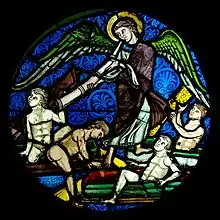
Et exspecto resurrectionem mortuorum (And I await the resurrection of the dead) is a suite for wind orchestra and percussion instruments by Olivier Messiaen, written in 1964 and first performed the following year. It is composed of five movements.
The piece is dedicated to the dead of the first and second world wars.
History
Messiaen was approached in October 1963 by André Malraux, Minister of Cultural Affairs under Charles de Gaulle, with a commission for a sacred work to commemorate the dead of the two World Wars. Originally envisioned as a work for chorus, large orchestra and brass, to be performed in June 1964 at the Sainte-Chapelle in Paris and at Notre-Dame de Chartres, the concept of the work and projected date of performance changed several times over the following year. Composition began in early July 1964, while Messiaen was vacationing at the Lac de Pétichet in the Hautes-Alpes, and the orchestration was completed early in January 1965 (Hill and Simeone 2005, 257–60). The title is taken from the penultimate line of the Nicene Creed: "Et exspecto resurrectionem mortuorum, et vitam venturi sæculi" (And I await the resurrection of the dead, and the life of the coming age).
It was premiered in the Sainte-Chapelle at 11:00 in the morning on 7 May 1965 (Cheong 2004, 115), and was performed for the second time in the morning of 20 June of the same year following a Solemn Mass at Chartres Cathedral and in the presence of President Charles de Gaulle, who warmly congratulated the composer after the performance (Hill and Simeone 2005, 263). Both performances were conducted by Serge Baudo, and the general rehearsal in Chartres on 19 June was filmed for television, later broadcast in the series Les grandes répétitions (Simeone 2010, 195).
In his prefaces to the second and third movements, Messiaen also paraphrases passages from "The Resurrection," from the supplement to the third part of the Summa Theologica by Thomas Aquinas (Bruhn 2008, 20–21).
Instrumentation
The piece is scored for woodwind, brass and percussion.
|
|
Movements
The piece has five movements, lasting approximately 35 minutes in total:
- "Des profondeurs de l'abîme, je crie vers toi, Seigneur: Seigneur, écoute ma voix!"
- "Le Christ, ressuscité des morts, ne meurt plus; la mort n'a plus sur lui d'empire."
- "L'heure vient où les morts entendront la voix du Fils de Dieu..."
- "Ils ressusciteront, glorieux, avec un nom nouveau -- dans le concert joyeux des étoiles et les acclamations des fils du ciel."
- "Et j'entendis la voix d'une foule immense..."
Discography (selected)
Yvonne Loriod, piano (in Couleurs de la cité céleste); Groupe instrumental à percussion de Strasbourg, Orchestre du Domaine Musical, conductor: Pierre Boulez. Erato 2292-45505-2/III ECD 71587, 1966-71. Originally issued on LP, 1967.
References
- Bruhn, Siglind. 2008. Messiaen's Interpretation of Holiness and Trinity: Echoes of Medieval Theology in the Oratorio, Organ Meditations, and Opera. Dimension and Diversity: Studies in 20th-Century Music 10, Mark DeVoto, general editor. Hillsdale, NY: Pendragon Press. ISBN 978-1-57647-139-5.
- Cheong, Wai-Ling. 2004. "Composing with Pre-composed Chords in the Finale of Et exspecto resurrectionem mortuorum". Revue de Musicologie 90, no. 1:115–32.
- Hill, Peter, and Nigel Simeone. 2005. Messiaen. New Haven and London: Yale University Press. ISBN 0-300-10907-5.
- Simeone, Nigel. 2010. "'Une œuvre simple, solennelle ...': Messiaen's Commission from André Malraux". In Messiaen the Theologian, edited by Andrew Shenton, 185–98. Farnham: Ashgate Publishing, Ltd.
Further reading
- Aubigny, Benoît. 2009. "Et exspecto resurrectionem mortuorum d'Olivier Messiaen: Perspectives apocalyptiques". In Sept regards sur l’oeuvre d’Olivier Messiaen, edited by Michel Fischer, 43–56. Observatoire Musical Français: Conférences et séminaires, No. 38. Paris: Université de Paris IV [Paris-Sorbonne] (Observatoire Musical Français). ISBN 978-2-84591-166-6.
- Bruhn, Siglind. 2008. Messiaen's Explorations of Love and Death: Musico-poetic Signification in the Tristan Trilogy and Three Related Song Cycles. Hillsdale, NY: Pendragon Press. ISBN 978-1-57647-136-4.
- Bruhn, Siglind. 2007. Messiaen's Contemplations of Covenant and Incarnation: Musical Symbols of Faith in the Two Great Piano Cycles of the 1940s. Hillsdale, NY: Pendragon Press. ISBN 978-1-57647-129-6.
- Harper, William Hudson. 1986. "Olivier Messiaen's Et exspecto resurrectionem mortuorum". PhD diss. Rochester: University of Rochester, Eastman School of Music.
- Lee, Chi-Kuen (Martin). 2010. "Biblical Narrative and Musical Symbolism in Messiaen's Et exspecto resurrectionem mortuorum". In Olivier Messiaen: The Centenary Papers, edited by Judith Crispin and Larry Sitsky, 122–57. Newcastle upon Tyne: Cambridge Scholars. ISBN 978-1-4438-2498-9.
- Lee, Chi-Kuen (Martin). 2011. "The Charm of Impossibilities: Musical Language, Theology, and Narrative Discourse in Olivier Messiaen's Et exspecto resurrectionem mortuorum". PhD diss. Buffalo: University of Buffalo, State University of New York.
- Nelson, David L. 2010. "Stratification of Music and Symbol in the Fourth Movement of Messiaen's Et exspecto resurrectionem mortuorum". In Olivier Messiaen: The Centenary Papers, edited by Judith Crispin and Larry Sitsky, 205–31. Newcastle upon Tyne: Cambridge Scholars. ISBN 978-1-4438-2498-9.
- Renshaw, Jeffrey. 1991. "Olivier Messiaen's Et exspecto resurrectionem mortuorum: An Interpretive Analysis". The Instrumentalist (November): 28–34.
- Von Gunden, Heidi Cecilia. 1977. "Timbre as Symbol in Selected Works of Olivier Messiaen". PhD diss. La Jolla: University of California, San Diego.